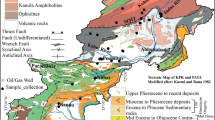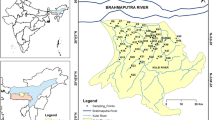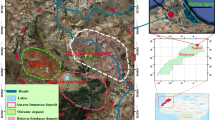Abstract
Accumulation of excess potentially toxic elements (PTEs) in soils poses a threat to human health as the agricultural ecosystem is closely related to the food chain. Accordingly, soil samples and groundwater samples were collected, and the soil samples were examined for pH, EC, As, Fe, Mn, Co, Cr, Cu, Al, Zn, Ni, Ba, B and F. The mean concentration of As, Co, Cr, Cu, Zn, Ni and Fe exceeded their geochemical background values impacting contamination from these toxic elements in the agricultural soils within study area. The PTEs-based various pollution indices are employed to aggregate and assess the toxic element pollution in the study area which indicates minor enrichment to moderately severe enrichment of Al, Ba, Cu, Zn, Fe, Mn, Ni and As within soils. This could be attributed to the accumulation of these elements from weathering of parent materials such as amphibolite, feldspar, hematite and ilmenite with partial input from the anthropogenic source like pesticides and fertilizers. Similarly, Nemerow comprehensive index also suggests that 60% of locations represent seriously contaminated class (Ps ≥ 5), due to the elevated concentrations of Cu, As and Zn. Likewise, the potential ecological risk with a mean value of 130.89, appears to be characterized by “considerable (100–200) to high contamination” (> 200) at about 53.33% locations. Hierarchical cluster analysis results also confirm that association of PTEs such as Cr, Ni, Fe, Mn, Zn, Ba and As in a cluster is indicative of anthropogenic source, and on the other hand, weathering of aluminosilicates of parent rock is mainly responsible for contamination of Co, Al, Cu and B. Above all, pH and F in soils have a close association with F in groundwater indicating the influence of soil in enriching F in groundwater, perhaps due to excessive drawdown of groundwater for agricultural activity.







Similar content being viewed by others
Data Availability
We shall produce the data upon which the Manuscript is based or any other material related to the contents of the Manuscript, for examination by the Journal, its editors or assignees should they request it at any stage of the publication process and even after publication of the Manuscript in the Journal.
References
Acosta, J. A., Faz, A., Martínez-Martínez, S., & Arocena, J. M. (2011). Enrichment of metals in soils subjected to different land uses in a typical Mediterranean environment (Murcia City, southeast Spain). Applied Geochemistry, 26, 405–414.
Adimalla, N. (2020). Heavy metals contamination in urban surface soils of Medak province, India, and its risk assessment and spatial distribution. Environmental Geochemistry and Health, 42(1), 59–75.
Agrawal, P., Mittal, A., Prakash, R., Kumar, M., Singh, T. B., & Tripathi, S. K. (2010). Assessment of contamination of soil due to heavy metals around coal fired thermal power plants at Singrauli region of India. Bulletin of Environmental Contamination and Toxicology, 85, 219–223.
Abrahim, G. M. S., & Parker, R. J. (2008). Assessment of heavy metal enrichment factors and the degree of contamination in marine sediments from Tamaki estuary, Auckland, Newzealand. Estuarine, Coastal and Shelf Science, 136(2008), 227–238.
Bhuiyan, M. A., Parvez, L., Islam, M. A., Dampare, S. B., & Suzuki, S. (2010). Heavy metal pollution of coal mine-affected agricultural soils in the northern part of Bangladesh. Journal of Hazardous Materials, 173(1–3), 384–392.
Canadian Council of Ministers of the Environment. (2007).Canadian soil quality guidelines for the protection of environmental and human health. Summary Tables. Updated September, 2007.
CGWB -Central Ground Water Board. (2013). Ground Water Information Booklet, Jamui District, Bihar, India.
Chaney, R. L., & Oliver, D. P. (1996). Sources, potential adverse effects and remediation of agricultural soil contaminants. In Contaminants and the soil environment in the Australasia-Pacific region (pp. 323–359). Springer.
Chen, H., Teng, Y., Lu, S., Wang, Y., & Wang, J. (2015). Contamination of health risk of soil heavy metals in China. Science of the Total Environment, 512–513(2015), 143–153.
Colak, M. (2012). Heavy metal concentrations in sultana cultivation soils and sultana raisins from Manisa (Turkey). Environmental Earth Science., 67, 695–712.
Dung, T. T. T., Cappuyns, V., Swennen, R., & Phung, N. K. (2013). From geochemical background determination to pollution assessment of heavy metals in sediments and soils. Reviews in Environmental Science Biotechnology, 12, 335–353.
Esmaeili, A., Moore, F., Keshavarzi, B., Jaafarzadeh, N., & Kermani, M. (2014). A geochemical survey of heavy metals in agricultural and background soils of the Isfahan industrial zone. Iran Catena, 121, 88–98.
Farrell, M., & Jones, D. L. (2010). Use of composts in the remediation of heavy metal contaminated soil. Journal of Hazardous Materials. https://doi.org/10.1016/j.jhazmat.2009.10.044.
Giri, S., Singh, A. K., & Mahato, M. K. (2017). Metal contamination of agricultural soils in the copper mining areas of Singhbhum shear zone in India. Journal of Earth System Science, 126–49.
Galuszka, A., Migaszewski, Z. M., Dolegowska, S., Michalik, A., & Duczmal-Czernikiewicz, A. (2015). Geochemical background of potentially toxic trace elements in soils of the historic copper mining area: A case study from Miedzianka Mt: Holy Cross Mountains, South Central Poland. Environmental Earth Science, 74(6), 4589–4605.
Hakanson, L. (1980). An ecological risk index for aquatic pollution control. A sedimentological approach. Water Research, 14(1980), 975–1001.
Huang, P., Li, T. G., Li, A. C., Yu, X. K., & Hu, N. J. (2014). Distribution, enrichment and sources of heavy metals in surface sediments of the North Yellow Sea. Continental Shelf Research, 73, 1–13.
Hooda, P. S. (2010). Trace elements in soils (pp 3–5). Wiley.
Islam, M. S., Ahmed, M. K., Habibullah-Al-Mamun, M., & Raknuzzaman, M. (2015). Trace elements in different land use soils of Bangladesh and potential ecological risk. Environmental Monitoring and Assessment, 187(9), 1–11.
Karavoltsos, S., Sakellari, A., Mihopoulas, N., Dassenakis, M., & Scoullos, M. J. (2008). Evaluation of the quality of drinking water in regions of Greece. Desalination, 224, 317–329.
Keshav Krishna, A., & Ram Mohan, K. (2016). Distribution, correlation ecological and health risk assessment of heavy metal contamination in surface soils around an industrial area, Hyderabad. India. Environmental Earth Sciences, 75(5), 411.
Kumar, S., Venkatesh, A. S., Singh, R., Udayabhanu, G., & Saha, D. (2018). Geochemical Signatures and isotopic systematics constraining dynamics of fluoride in groundwater across Jamui district, Indo-Gangetic alluvial plains, India. Chemosphere., 205, 493–505.
Kumar, S., Singh, R., Venkatesh, A. S., Udayabhanu, G., & Sahoo, P. R. (2019). Medical Geological assessment of fluoride contaminated groundwater in parts of Indo-Gangetic Alluvial plains. Scientific Reports, 9(1), 1–16.
Li, W. X., Zhang, X. X., Wu, B., Sun, S. L., Chen, Y. S., Pan, W. Y., Zhao, D. Y., & Cheng, S. P. (2008). A comparative analysis of environmental quality assessment methods for heavy metal-contaminated soils. Pedosphere, 18(3), 344–352.
Liu, G., Yu, Y., Hou, J., Xue, W., Liu, X., Liu, Y., Wang, W., Alsaedi, A., Hayat, T., & Liu, Z. (2014). An ecological risk assessment of heavy metal pollution of the agriculture ecosystem near a lead-acid battery factory. Ecological Indicators, 47, 210–218.
Longhurst, R. D., Roberts, A. H. C., & Waller, J. E. (2004). Concentrations of arsenic, cadmium, copper, lead, and zinc in New Zealand pastoral topsoils and herbage. New Zealand Journal of Agricultural Research, 47(1), 23–32.
Loring, D. H. (1991). Normalization of heavy-metal data from estuarine and coastal sediments. ICES Journal of Marine Science, 48, 101–115.
Maanan, M., Saddik, M., Maanan, M., Chaibi, M., Assobhei, O., & Zourarah, B. (2015). Environmental and ecological risk assessment of heavy metals in sediments of Nador lagoon, Morocco. Ecological Indicators, 48, 616–626.
Marier, J. R., & Rose, D. (1971). Environmental fluoride. National Research Council of Canada.
Muller, G. (1969). Index of geo-accumulation in sediments of Rhine river. GeoJournal, 2, 108–118.
Mileusnic, M., Mapani, B. S., Kamona, A. F., Ruzicic, S., Mapure, I., & Chinwamurombe, P. M. (2014). Assessment of Agricultural soil contamination by potentially toxic metals dispersed from improperly disposed tailings, Kombat mine, Namibia. Journal of Geochemical Exploration, 144, 409–420.
Ma, L., Sun, J., Yang, Z., & Wang, L. (2015). Heavy metal contamination of agricultural soils affected by mining activities around the Ganxi River in Chenzhou, Southern China. Environmental Monitoring Assessment., 187, 731.
Paetz, A., & Crobmann, G. (1994). Problems and results in the development of international standards for sampling and pretreatment of soils. Environmental sampling for Trace analysis (p. 334). VCH Publishers.
Reddy G. R. S., & CGWB -Central Ground Water Board. (1983). Report on the hydrogeological conditions in Jamui-Sikandra-Malaipur area, Monghyr district, Bihar.
Sakan, S. M., Đorđević, D. S., Manojlović, D. D., & Predrag, P. S. (2009). Assessment of heavy metal pollutants accumulation in the Tisza river sediments. Journal of Environmental Management, 90(11), 3382–3390.
Singh, R., Venkatesh, A. S., Syed, T. H., Reddy, A. G. S., Kumar, M., & Kurakalva, R. M. (2017a). Assessment of potentially toxic trace elements contamination in groundwater resources of the coal mining area of the Korba Coalfield, Central India. Environmental Earth Sciences. https://doi.org/10.1007/s12665-017-6899-8.
Singh, R., Syed, T. H., Kumar, S., Kumar, M., & Venkatesh, A. S. (2017b). Hydrogeochemical assessment of surface and groundwater resources of Korba coalfield, Central India: Environmental implications. Arabian Journal of Geosciences, 10, 318. https://doi.org/10.1007/s12517-017-3098-6.
Singh, R., Venkatesh, A. S., Syed, T. H., Surinaidu, L., Pasupuleti, S., Rai, S. P., & Kumar, M. (2018). Stable isotope systematics and geochemical signatures constraining groundwater hydraulics in the mining environment of the Korba Coalfield, Central India. Environmental Earth Sciences, 77(15), 548. https://doi.org/10.1007/s12665-018-7725-7.
Skordas, K., Papastergios, G., & Fillipidis, A. (2013). Major and trace element contents in apples from a cultivated area of Central Greece. Environmental Monitoring Assessment., 185, 8465–8471.
Sumner, M. E. (2000). Beneficial use of effluents, wastes, and biosolids. Communications in Soil Science and Plant Analysis, 31(11–14), 1701–1715.
Turekian, K. K., & Wedepohl, K. H. (1961). Distribution of the elements in some major units of the earth’s crust. Geological Society of America Bulletin, 72, 175–192.
Tomlinson, D. J., Wilson, J. G., Harris, C. R., & Jeffrey, D. W. (1980). Problems in the assessment of heavy metal levels in estuaries and the formation of a pollution index. Helgoland Marine Research, 33(1–4), 566–575.
USEPA (United States Environmental Protection Agency) 1994. Microwave assisted acid digestion of siliceous and organically based matrices; US Environmental Protection Agency ,Office of Solid Waste and Emergency Response, Government Printing Office,Washington.
Wuana, R. A., & Okieimen, F. E. (2011). Heavy metals in contaminated soils; A review of sources, chemistry risks and best available strategies for remediation. ISRN Ecol, 2011, 1–20.
Wei, B., & Yang, L. (2010). A review of heavy metal contamination in urban soils, urban road dusts and agricultural soils from china. Micro Chemical Journal., 94, 99–107.
Wyatt, C. J., Fimbers, C., Romo, L., Mendez, R. O., & Grijalva, M. (1998). Incidence of heavy metal contamination in water supplies in Northern Mexico. Environment Research A, 76, 114–119.
Yadav, N., Rani, K., Yadav, S. S., Yadav, D. K., Yadav, V. K., & Yadav, N. (2018). Soil and water pollution with fluoride, geochemistry, food safety issues and reclamation—A review. International Journal of Current Microbiology and Applied Sciences, 7, 1147–1162.
Acknowledgements
The authors would like to acknowledge IIT (ISM), Dhanbad and CGWB management for their continuous support and facilities extended towards publication of this paper. The ideology addressed in this paper solely belongs to the authors only and not necessarily of their organization.
Author information
Authors and Affiliations
Corresponding author
Ethics declarations
Conflict of Interest
It is also assured that the work described has not been published elsewhere and there is no conflict of interest.
Additional information
Publisher's Note
Springer Nature remains neutral with regard to jurisdictional claims in published maps and institutional affiliations.
Supplementary Information
Below is the link to the electronic supplementary material.
Rights and permissions
About this article
Cite this article
Kumar, S., Singh, R., Venkatesh, A.S. et al. Assessment of Potentially Toxic Elements Contamination on the Fertile Agricultural Soils Within Fluoride-Affected Areas of Jamui District, Indo-Gangetic Alluvial Plains, India. Water Air Soil Pollut 233, 39 (2022). https://doi.org/10.1007/s11270-021-05488-3
Received:
Accepted:
Published:
DOI: https://doi.org/10.1007/s11270-021-05488-3




